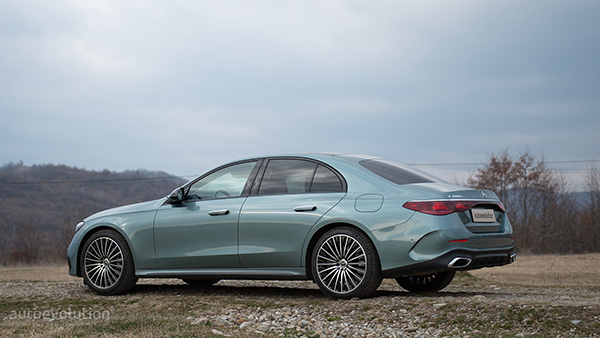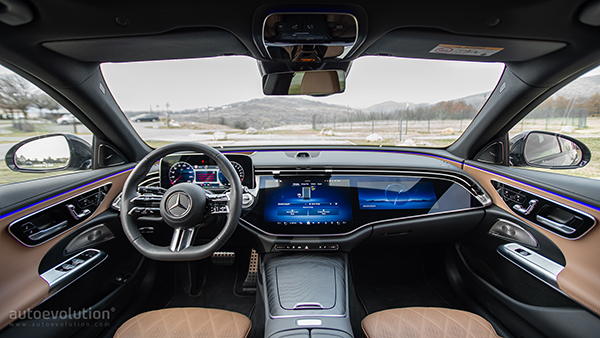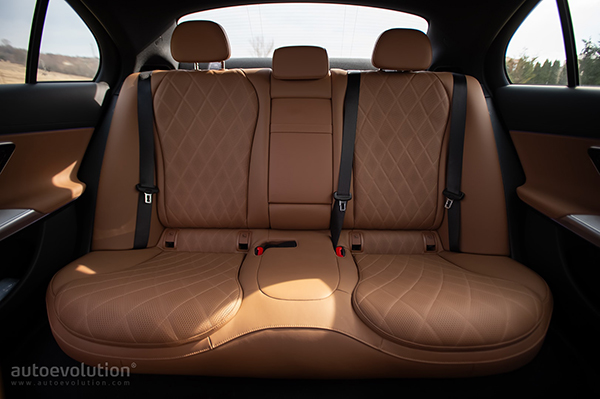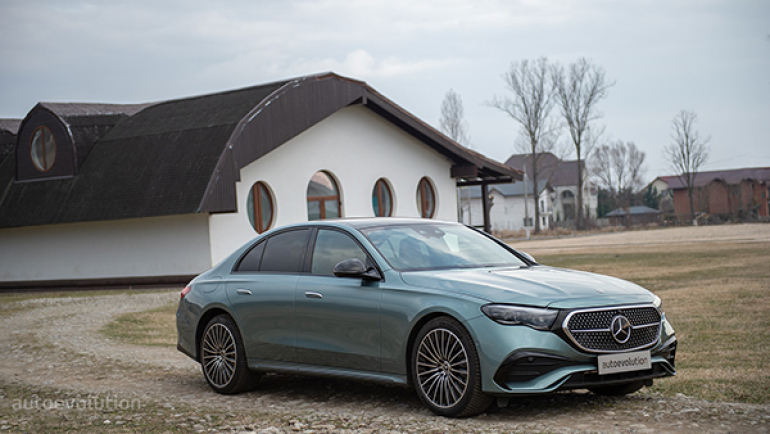With a lineage that traces back decades, the Mercedes-Benz E-Class stands as a testament to elegance and cutting-edge engineering. It also happens to be one of my favorite cars in the world, so this review won’t be biased at all. Just kidding. It’s precisely because I know the E-Class so well, that I’m not going to pull any punches when it comes to this all-new W214 model.
I’ve reviewed all E-Class generations from the W210 onwards (the one that came out in 1994), and then my dad’s old W123 was one of the cars he would let me drive in non-traffic areas and secluded backroads as a kid. This is one of those vehicles where you’ll always know what to expect, and you’ll likely never be disappointed by what you get.
You could get into a W211 today and still feel like you’re in a proper premium sedan – as long as it’s been well-maintained. Same goes for the W212, those things make for terrific used purchases, although I tend to favor the pre-facelift version as far as styling is concerned. Put an AMG pack on it and it’s going to look like a million bucks.

I feel the same way about the W213, surprisingly. I think the pre-facelift version looks better, although looks were never an issue with the previous-gen E-Class. Rather, some people pointed out various cost-cutting measures undertaken by Mercedes, resulting in an interior that didn’t feel as plush as expected.
It’s true, some of the plastics used in the W213 were a bit of a letdown, but only if you’re nitpicking to some extent. Still, the same issue persists on this all-new W214 model, although the interior as a whole looks absolutely amazing. The visuals and overall ambiance are both terrific, but more on that later.
Design Evaluation
The E-Class has always had this commanding presence about it. Sort of an understated luxury. It doesn’t beg for attention, but you’ll notice it when it’s there.
Mercedes unveiled the all-new W214 in April of last year, using the rear-wheel drive based MRA II platform as its underpinnings. It’s grown compared to its predecessor – it’s longer by about 1.0 in (25 mm), wider by 1.1 in (28 mm) and just a tiny bit taller (by less than an inch). The wheelbase is longer too, but you’re not going to notice it in terms of passenger comfort.
The plug-in hybrid variants sit even closer to the road than their mild hybrid counterparts (by 0.59 inches / 15 mm), although to tell you the truth, I didn’t even notice.
From a 90-degree side angle, the W214 is instantly recognizable as an E-Class. It sort of looks like a smaller S-Class, which is nothing else but a compliment. The front fascia? It’s got this high gloss black insert between the headlights and the grille and personally I’m not a big fan of this look. It’s very EQ-ish. I also don’t think the headlights are as nice as the ones on the old W213.
The light signature has these “eyebrows” that make the W214 look maybe a bit too pretty? Don’t get me wrong, pretty is good on most cars, but in this case, it doesn’t really fit the personality of the E-Class. I think the AMG Line spec non-facelifted W213 has the best front fascia design of any E-Class, followed by a similarly specified non-facelifted W212. The W214 wouldn’t even make my Top 3 as far as front-end styling is concerned.
The rear, on the other hand, is less polarizing, albeit still a bit too EQ-ish. Yes, I’m not a big fan of Mercedes’ EQ-brand models. Get over it. I do like the three-pointed star motif taillight signature, so there’s that.
Sticking with what I really liked, the pop-out door handles are somewhat cool, and then there’s the color on our test car – it’s Mercedes’ so-called Verde Silver, which we ranked second in our 10 Best New Car Colors of 2023 feature story. Initially, I thought that the color would look more “silver” from certain angles (like it did in some media images), but in real life the green hue shines through predominantly.

Other exterior features worth highlighting include the AMG Line spec with the AMG Styling package, Night Package, the 20-inch multi-spoke AMG wheels, Digital Light function, panoramic sunroof, and the illuminated radiator grille. That last one is a bit of a gimmick, but whatever.
Overall, I think Mercedes did a solid job with the design of the all-new E-Class. The front end could have been a lot better, but I’m not going to complain too much. I like that they played it somewhat safely and didn’t turn the W214 into an EQE twin, styling-wise.
Interior Assessment
The W214 is actually Mercedes’ first non-EQ product fitted with the MBUX Superscreen, featuring a three-display setup pairing two 12.3-inch screens with a larger one in the middle (not sure about the exact size, but it doesn’t look as big as the Hyperscreen’s 17.7-inch middle display).
The so-called Superscreen also comes with a selfie camera, and you’ve got tons of customization available, especially for the Active Ambient Lighting (64 available colors) which can even keep up with the beat of whatever song you’re listening too – that tends to get old really fast though, and you end up just going with a basic setting, like a single color or a dual-color setup that doesn’t constantly blink in your face.
Ambient lighting aside, the overall design of the dashboard is impressive too. It’s got that wraparound feel to it, like you’re inside a luxury boat. Is it better than the interior design on the W213? I couldn’t tell you. I think they both look equally good. The two models even share nearly identical steering wheels.

I guess the presence of the Superscreen points to a more modern environment, but not everyone loves giant screens. If you’re over 40, you’re probably already sick and tired of a lot of the tech we’re being bombarded with, especially since some of this stuff tends to be overly complicated, as opposed to just pushing a physical button for a simple function.
In terms of build quality, it’s pretty darn good overall, but there are certain cheap(er) plastic bits right where you wouldn’t expect them. Like the turn indicator or the column shifter – both feel like they’ve been taken off some… non-premium product. Let’s just leave it at that.
Another thing I didn’t like – how fingerprint prone those screens were. Ridiculous. You need to constantly drive around with a cloth in the car just to wipe that stuff down.
Meanwhile, the comfort is excellent, although the seats weren’t as comfortable as they looked. They were surprisingly hard. I’m currently driving the all-new G60 BMW 5 Series, and its seats are infinitely more comfortable than the ones in the W214 E-Class. I’m just as surprised as you. But maybe I’m just old.
Then there’s the on-board tech. This car came loaded with just about every possible driving assistant system, to go with the MBUX Premium system, the Energizing Package, a Head-up display, 3D driver’s display (thankfully you can turn that off), Burmester 4D sound system, the previously mentioned active ambient lighting tech, Keyless Go, 360 cameras, Parktronic, and the ventilated seats with memory function.
Speaking of the seats, they were upholstered in Tonka brown Nappa leather and definitely looked the part. I just wish they were a little more plush.
As for how much space there is for backseat passengers, I’d say that it’s adequate for this type of car, no complaints. You’ll still have sufficient knee and legroom even if you’re over 6’0” tall. But if you’re worried about the kids having enough room, and you need room for strollers and everything, you already know you need an SUV and not a four-door sedan.
Before I forget, props to Mercedes for figuring out some people might unwillingly leave their phones in the car, since the wireless charging pad has a cover that you can open and close. Worry not though, because if your phone is still charging when you shut off the engine and open the door, the MBUX system will warn you via the speakers saying: “Just a moment. Your phone is still in the car.” Brilliant.
Driving Take
Powertrain characteristics aside, the W214 E-Class drives exceptionally well. It glides around just like a Benz is supposed to glide, but it also feels supremely planted. The steering feel is particularly impressive. It’s even better than in the G60 5er – but you’ll have to wait a little while longer until we publish that story.
The Airmatic suspension soaks up bumps and imperfections with ease, and it wouldn’t be overstating it to say that the W214 E-Class is no. 1 in its segment in terms of driving comfort, which is what matters most to some people. Not everyone cares how quickly you can go around a corner in a mid-size family sedan – and if they do care about that extra 0.1 seconds like they’re on some freaking quick lap at Spa, you can pretty much go ahead and discard their opinion.
Another amazing characteristic is the turning circle. Courtesy of its rear axle steering system, the new E-Class will turn its rear wheels opposite the ones at the front at a 4.5-degree angle up to nearly 40 mph (64 kph). Then, the rear wheels turn with the front wheels at a 2.5-degree angle. What’s cool is that you can perform a 180-turn in this 16.2-foot-long (2.96 m) sedan with greater ease than you would in a Corolla.
Overall, the W214 has one of the best steering feels/characteristics I’ve ever experienced in this segment, and this goes for both low-speed and high-speed maneuvering. Rest assured; it just eats up the miles as soon as you get on the highway.
When you do want to go quicker in the E 400 e 4Matic, you most definitely can – and to a rather impressive degree. This specification is powered by a plug-in hybrid system comprised of a turbocharged 2.0-liter four-cylinder engine and a 95-kW electric motor working alongside a 25.4 kWh battery. Altogether, you’re putting down 375 horsepower (381 ps) and 480 lb-ft (650 Nm) of torque, which in turn should get you to 60 mph in about 5.2 seconds with the help of a 9-speed automatic gearbox (which happens to be excellent). This is definitely quick enough, especially for a car that weighs 2.2 tons (nearly 5,000 lbs).
Meanwhile, the electric motor alone produces 127 hp (129 ps), and it’ll take you all the way to 87 mph (140 kph) without having to engage the internal combustion engine. It’s not particularly quick, but it’s comparable to certain low-budget European EVs in terms of 0-60 times.
On a more personal level, I can’t tell you that all plug-in hybrid systems are automatically great, because a car’s electronic brain will constantly be adjusting things like regenerative braking and throttle input, which in turn can make the vehicle feel a bit inconsistent in how it drives.
I did experience some of this in the E 400 e. Sometimes it would coast, other times it would “engine brake” out of nowhere, so make sure you set things up just right before you hit the road. You can choose between four regen brake settings (from coasting to “almost” full-on one pedal driving).
Everyday Living
The EV range on this car is rated at 69 miles (111 km). In other words, for a plug-in hybrid running under electric power only, this gets a big thumbs up.
In terms of fuel economy, Mercedes claims a combined 261 mpg (WLTP), but that’s with the electric motor combined. I think it would be tough to get anywhere near that in day-to-day conditions (you’d need the battery fully charged and you’d have to drive efficiently), plus, PHEVs have long been suspected of being nowhere near as efficient in real-world use, so take everything with a grain of salt.
As for a more conventional figure for the combustion engine, I think you can get it to about 30 mpg (7.5L/100 km), no problem. Oh, and before I forget, you can’t fast-charge the battery on this thing, but on the plus side, PHEV owners don’t usually suffer from any range and/or recharge anxiety. Still, the best you can hope for is about 20 min for a 0-80% charge, but it really depends on where you charge it. It can also take a couple of hours.
Moving on to something a little different, but still practicality-related, we need to talk about trunk volume, which leaves a lot to be desired in the E 400 e. All you get is 13 cu.ft of cargo space, about 370 liters. Meanwhile, a non-plug-in hybrid variant will offer you 19 cu.ft (540 liters). It shows how some PHEVs just aren’t as practical as pure gasoline or diesel-powered models.
Finally, we arrive at the price. Our test car kicks off from €69,781, but with nearly €19,000’s worth of options, the final price stood at €110,166, taxes included. That’s roughly $120,000.
What does this mean for U.S. buyers? Well, the 2024 E-Class is just now going on sale in the States, where you’ll be able to buy it in E 350 and E 450 specifications, for starters. The E 450 isn’t exactly the equivalent of our E 400 e tester, but it comes close in terms of performance.
Powered by a turbocharged 3.0-liter inline-six engine, the E 450 Matic produces 375 horsepower in exchange for $69,250. The E 400 e might cross the Atlantic too, but as of right now, we don’t know anything about any potential MSRP.
Test Drive Roundup
There aren’t a lot of negative things you can say about the all-new E-Class. Sure, maybe the front-end styling isn’t perfect, but if you nail the specification, you’ll be thrilled to own such a car long-term. It’s also clearly an upgrade over the W213 in terms of on-board tech. One might say that today’s E-Class is closer to the S-Class than ever before.
Bottom line: amazing ride quality, amazing tech, both relaxing and engaging to drive – what more can you ask from a mid-size premium sedan?
Pros
– Comfort
– Tech
– Overall design
– Driving Dynamics
Cons
– Lackluster front-end styling
– Limited trunk space in PHEV form
Source: mercedes-world.com











